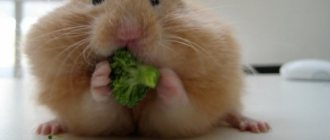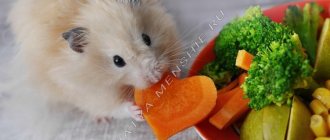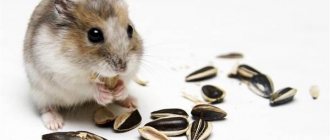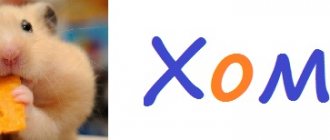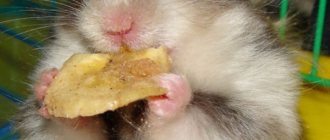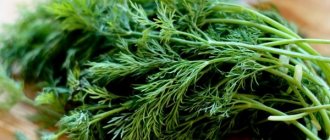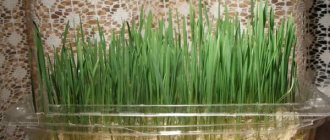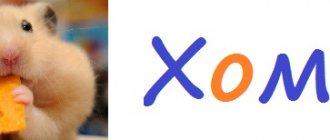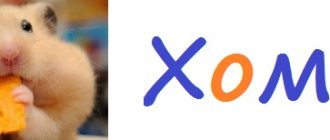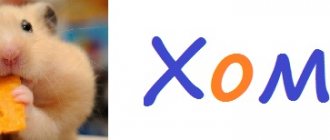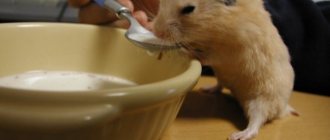- home
- Nutrition
28.03.2018
Can hamsters have apples? This question worries many pet owners. This fruit is common and popular among people, but can you feed it to a hamster? The product is quite suitable as food and contains many useful microelements and vitamins. Below you will find out why apples are useful, what varieties are suitable for food, in what quantity and form they need to be presented to the hamster, and how to introduce the product into the diet.
Benefits of the fruit
Both dried and pure, raw apples can bring a lot of benefits to the animal. They contain vitamins of groups E, P, K, B-group, as well as citric and ascorbic acids. Such a set is necessary for a developing, growing organism, which is why the answer to the question “is it possible to give hamsters apples?” positive. No harmful substances that could harm the hamster were found in apples.
Sweet varieties are much more attractive to children, but it is important to remember that they contain a huge percentage of sugar (about 16%). And it’s difficult to find such environmentally friendly apples. You should not get carried away with this fruit; it is better to choose varieties that are more neutral in taste (but not very sour).
Dried apples are not inferior in their properties to their fresh counterparts. The only negative is that they contain much less moisture, which quenches your pet’s thirst. Therefore, before serving them, you should keep the dried fruits in warm water for several hours, waiting until they swell.
This is interesting: Where do squirrels live?
Is it possible to give hamsters apples?
Apples can and should be given to hamsters, including Djungarian and Syrian ones. You should start complementary feeding with a small piece; if everything went well and the pet liked the treat, you can increase the portion.
Don't forget to remove all the seeds from the fruit. They contain amygdalin, a substance derived from hydrocyanic acid that can cause poisoning. And although there is very little of it in the bone, and this content of the substance does not pose a danger to humans, an animal of small mass can suffer.
Did you know? The total area of all apple orchards on the planet is more than 50 thousand km. This is larger than the territory of such countries as Slovakia, the Netherlands, Denmark, Belgium, and Switzerland.
How to feed the dzhungarik correctly?
Djungarians are cute and funny hamsters that are not at all difficult to keep at home. In most cases, it is enough to purchase a cage, fill it with the necessary toys and accessories, and also provide the fluffy with regular and high-quality food. What kind of diet will be healthy and complete for a hamster?
If you do not adhere to certain nutritional rules, the animal may get sick, which often leads to a sad end. The mistake of many Djungarian pet owners is that they let their pets try absolutely everything from their table.
And hamsters eat everything that is offered. This is strictly forbidden. If the owner of a hamster does not want to shorten the animal’s already short life span, then you should familiarize yourself with the basic rules of nutrition and a healthy diet.
What are the benefits for a hamster?
The apple is one of the most popular fruits in the world, grown on every continent except Antarctica.
These fruits are rich in the following minerals:
- potassium;
- calcium;
- magnesium;
- sodium;
- silicon;
- iron;
- cobalt;
- cobalt;
- manganese;
- molybdenum;
- zinc;
- chromium;
- copper.
The fruit contains large quantities of vitamins of the following groups: A, B, C, E, H, PP, K.
The fruit almost never causes allergies, and is also useful for rodents for the following reasons:
- thanks to its rich, balanced vitamin composition, strengthens the immune system;
- high potassium content has a beneficial effect on blood vessels and the heart;
- a large amount of iron in the fruit helps to increase hemoglobin;
- minerals such as copper, zinc and some others have a positive effect on the composition and quality of blood;
- fiber enhances intestinal motility and has a beneficial effect on the state of the gastrointestinal tract as a whole.
Reasons for banning pomegranate
First you need to figure out what it is. Pomegranate is an exotic fruit that contains calcium, vitamins, iron, phosphorus, and magnesium. For humans this is a treasure trove of useful substances, but for a hamster the product is dangerous.
The body cannot cope with the acidity contained in the fruit and can cause severe stomach pain. A large amount of vitamins also leads to hypervitaminosis, and bones can damage an already weak digestive system. You should not give pomegranate bark, so that your pet does not suffer from severe constipation. Pomegranate seeds contain fat, which adversely affects the functioning of the animal’s liver, and the essential oils of the fruit cause an allergy attack.
Choosing a variety
Which variety to choose for dzungaria and do you need to process the fruits? There is no need to choose varieties that are too sweet; your pet will like them, but they can be harmful to health. Too sour fruits are also not suitable; ripe, moderate-tasting fruits are best. If you choose a fruit that is not ripe enough, the animal may have digestive problems.
Regarding processing, the rules are:
- Store-bought apples must be peeled; the fruits may be treated with chemicals. This condition especially applies to fruits purchased in winter. In cold weather, it is better not to buy them for your pet.
- Homemade fruits must be washed.
- Dried apples are better for winter. Soak them in water before giving them to your hamster.
- Fruits must be washed thoroughly under running water.
Is it possible to give the peel
Apple peel contains many nutrients, fiber and vitamins. But store-bought apples are treated with pesticides and chemicals that accumulate in the peel and can kill the hamster.
Does he need much? You can feed the peel from those apples that grew in your dacha; in other cases, feed only the pulp.
Citrus fruits (oranges, tangerines and lemons)
Absolutely any citrus fruits (tangerine, lemon, lime, orange, grapefruit, pomelo) cannot be given to hamsters. These fruits are harmful for the following reasons:
- a high content of vitamin C can provoke hypervitaminosis;
- acids from citrus fruits corrode tooth enamel and irritate the mucous membranes of the esophagus, stomach and intestines;
- cause allergies.
It must be remembered that both the pulp of citrus fruits and their peel are harmful. Even intensive washing is not able to wash away the chemicals used for preservation from imported fruits.
This is interesting: What oceans and seas wash the shores of Africa?
Well, at least a little...
You can try a drop. Moreover, 1 drop of juice is exactly one drop. Not more. In winter, the amount of vitamin C in the hamster’s body decreases. Fresh grass and vegetables are more difficult to get than in summer. But pomegranate is always full of these vitamins. Even in winter. If you have decided, at any cost, to expand your pet’s diet and provide him with vitamin supplements, here is one piece of advice:
Experts suggest diluting 2 drops of juice in half a glass of clean water. Just don’t give all this half a glass to the hamster at once. Let him drink plain water. This way you can compensate for the lack of vitamins in your hamster.
All processes occurring in the hamster’s body occur very quickly, including diseases. In order for your pet to be healthy and cheerful, it is necessary to exclude this fruit, which is healthy for humans, from the list of food products. By taking care of your hamster and following the recommendations, you can increase its lifespan.
Beneficial features
Apple is a low-allergenic fruit. It is good to eat to:
- strengthen the immune system (due to the high content of vitamins);
- maintain a normal cardiovascular system (potassium will help with this);
- increase hemoglobin (this fruit contains a lot of iron);
- improve blood composition (this indicator is affected by copper, zinc and other trace elements).
These familiar fruits also contain a lot of fiber, which has a positive effect on intestinal motility. Rodents should also be fed apples to prevent the development of tumors.
Why you shouldn't give too much
The idea of whether to feed a hamster an apple is no longer in doubt - these fruits should be in their diet. If used in moderation, no substances were found in them that could be harmful. Therefore, it is necessary to adhere to the advice recommended by veterinarians. The product must be fresh and not treated with harmful chemicals. It is best if the apples are from your own garden or purchased at the market from trusted sellers. Stores sell fruits with special mixtures applied to them so that they do not spoil or wither. This product will not be beneficial for your pet. “Wormy” fruits are considered especially clean.
It is necessary to give a small amount and no more often than every one or two days. This is not the main food, but rather serves as a dessert or complementary food. His main diet consists of special grain mixtures.
Excessive consumption of fruits can cause increased gas formation, stomach problems, excess weight, and even increased blood sugar levels.
Don't forget that fruit spoils soon. Make sure that the leftovers do not end up among the animal’s main food and that rotting does not begin, which will have a detrimental effect on the small organism and on its other food products. Check periodically to see if he has buried pieces “in reserve” somewhere in his house.
But maybe it’s still possible, if you’re careful
The hamster is a very curious animal and puts almost everything into its mouth. The teeth need to be ground down with something. So, if a pomegranate seed falls into his paws, he will eat it without hesitation. But, as we have already said, not everything that is useful for people is also useful for hamsters.
But it’s delicious... is it really impossible? Even a grain?
Yes, pomegranate is the king of fruits. We will modestly keep silent about Thai durian, where can you find it here? By the way, I wonder if a hamster can have durian?
Stop. We got distracted. Let's continue. The problem with pomegranate is that it is very rich in all kinds of vitamins and microelements. It is in them that its danger for the hamster lies.
For reference: pomegranate contains about 15 amino acids, five of which are essential for the body. Also, it is rich in vitamins K, C, B9 and B6 and minerals (potassium, copper, phosphorus). With all this richness, it is a low-calorie fruit. There are only 72 kilocalories in 100 grams.
So why is it so harmful to our furry pets:
- Tannins found in the fetal crust slow down the peristalsis of the intestinal tract, which leads to constipation. Considering the size of the animal and its rapid metabolism, this constipation could cost him his life. Also, the peel of the fruit contains some alkaloids, which can simply kill the poor fellow.
- The fat contained in pomegranate seeds puts a lot of stress on the liver.
- A high content of vitamins will lead to hypervitaminosis (to put it simply - too much), which is also not good for poor Khoma.
- Too much acidity in pomegranate juice is bad for the digestive system.
- Don't forget about common allergies. In the wild, hamsters are unlikely to eat pomegranate, so there is no immunity to new substances in the animal’s body. If you see that your pet is often itching, his eyes are red and tears are flowing, then most likely the poor thing is suffering from allergies or poisoning. Urgently remember what you fed and try not to give this food again.
Yes, pomegranate is a wildly useful thing, but not for hamsters.
Interesting fact: Syrian hamsters are less susceptible to pomegranate, since they still have a chance to try it in the wild. But it’s still not worth giving a Syrian a pomegranate on purpose. It’s better not to even show it to the Djungarians at all.
Features of introduction into the diet
A hamster can only eat a ripe apple, because an unripe fruit will cause diarrhea. The age and condition of the animal also matters - pregnant females, babies (up to 1 month), as well as elderly individuals should not be given such fruits. These hamsters will not be able to digest large amounts of fiber and will suffer from indigestion.
In winter, instead of feeding the animal not very healthy fruits bought in the supermarket, it is better to give it dried apples. Fruits of local varieties collected from your own apple tree or purchased in the fall should be prepared in advance. Such complementary foods will be much healthier than fresh fruits treated with preservatives.
Well, at least a little...
You can try a drop. Moreover, 1 drop of juice is exactly one drop. Not more. In winter, the amount of vitamin C in the hamster’s body decreases. Fresh grass and vegetables are more difficult to get than in summer. But pomegranate is always full of these vitamins. Even in winter. If you have decided, at any cost, to expand your pet’s diet and provide him with vitamin supplements, here is one piece of advice:
Experts suggest diluting 2 drops of juice in half a glass of clean water. Just don’t give all this half a glass to the hamster at once. Let him drink plain water. This way you can compensate for the lack of vitamins in your hamster.
All processes occurring in the hamster’s body occur very quickly, including diseases. In order for your pet to be healthy and cheerful, it is necessary to exclude this fruit, which is healthy for humans, from the list of food products. By taking care of your hamster and following the recommendations, you can increase its lifespan.
Which variety to choose and whether the fruits need to be processed
Before choosing a fruit for complementary feeding, you need to understand whether the hamster can have a sweet variety of apple, completely without acid, or, on the contrary, very sour.
The high fructose content in sweet varieties is not beneficial for small rodents due to the likelihood of diabetes. Too sour fruits will have an adverse effect on the baby’s delicate stomach. It is better to give preference to sweet and sour varieties, preferably ripened in the area where you live.
To avoid poisoning your pet, peeled apples must be processed. It is better to cut off the skin of purchased fruits. If the fruits are collected from your own garden, you should simply wash them thoroughly.
Before you treat your furry friend, you must remove all the seeds, because they contain hydrocyanic acid, which is dangerous for rodents, and you should not allow your baby to eat them.
List of do's and don'ts
The list of foods that will negatively affect your rodent's health is not so small. It is worth remembering it, or better yet, writing it down, so that you never make a mistake when giving another treat to your hamster. So, hamsters should not eat foods such as:
- Cheese (in any form of any kind);
- Food for other animals (parrots, birds and other rodents);
- Potatoes (in any form);
- Persimmon (a variety that knits);
- Acorns;
- Drops for rodents;
- White and black bread;
- Crispbread (spicy with seasonings);
- Brazilian nut;
- Salt;
- Sugar;
- Spices (any);
- Butter;
- Citrus;
- Almond;
- Muesli and breakfast cereals;
- Onions (leeks and onions);
- Garlic;
- Bones (cherry or apricot);
- Potato peel;
- Cabbage (white and red);
- Sausages (any);
- Milk (cow and goat in any form);
- Sour cream;
- Cream;
- Exotic fruits and aphrodisiacs (kiwi, pineapple, pomegranate, avocado);
- Fried and fatty foods;
- Pasta (dry);
- Watermelon;
- Sorrel;
- Kozinaki;
- Mushrooms;
- Coniferous branches (pine, spruce, spruce, larch, etc.);
- Fruit juices;
- Mint;
- Tulip;
- Insects (caught from nature);
- Greens (picked within the city or near roads);
- Figs;
- Ice cream;
- Chocolate;
- Cookies (any other sweets).
Now, knowing exactly what you can feed your hamster, you can properly organize its nutrition and keep it healthy. Remember that proper care of your pet, even such a small one, will give you and him many years of joy.
Best regards, Evgeniy.
Veterinarians recommend adding fresh, juicy fruits to the diet of captive rodents. In this article, we will consider whether hamsters can have apples, whether it is worth giving pets dried fruits, whether to peel fresh ones, and which varieties to prefer.
Let’s say right away that you can and should give your hamster an apple; it will only bring benefits to your pet. However, there are some points that need to be taken into account before treating the animal with new food.
Apple is a low-allergenic fruit. It is good to eat to:
- strengthen the immune system (due to the high content of vitamins);
- maintain a normal cardiovascular system (potassium will help with this);
- increase hemoglobin (this fruit contains a lot of iron);
- improve blood composition (this indicator is affected by copper, zinc and other trace elements).
These familiar fruits also contain a lot of fiber, which has a positive effect on intestinal motility. Rodents should also be fed apples to prevent the development of tumors.
Plant food
Fruits in syrup, compote berries, and jam should not be offered to rodents. Any preserved food is prohibited because it contains sugar and salt. Raw seasonal fruits are preferred for feeding. Some of them are placed in the cage boiled (zucchini, beets, carrots, pumpkin). The cooking time in this case is minimal. The water is not salted.
If fresh fruits and vegetables are purchased at the store, it is better to cut off the skin (it often contains pesticides). For home harvest, this step is not necessary. Plant foods, including those from your own garden, must be thoroughly washed. After all, harmful bacteria and helminth eggs may remain on its surface.
All fruits must be fresh, not chapped, and free of rot. The pits of cherries, apples, cherries, plums, and apricots must be removed. The hamster can be poisoned by them. If a pear, pepper or other delicacy is cut into several pieces, the remaining pieces are stored in the refrigerator for several days.
It is important to remember that excessive fruit feeding causes indigestion and increased gas formation in hamsters, and increases the risk of diabetes and obesity. In small quantities, fruits help strengthen the immune system, improve intestinal motility, and are involved in the prevention of many diseases.
Best regards, Evgeniy.
Prohibited Products
Some harmless products can be dangerous for both Syrian and Djungarian hamsters. List of what you should not feed them:
- food intended for parrots or other rodents;
- acorns, chestnuts, potatoes;
- cheese, lard, any products containing more than 3% fat;
- spices;
- almond;
- dairy products;
- sweets, juices;
- fatty food;
- white cabbage is dangerous and fatal;
- garlic, onion;
- chocolate;
- citrus, exotic fruits;
- seeds, seeds of any fruit;
- captured insects that are not typical for the diet of dwarf birds;
- canned, stewed, fried, smoked foods;
- butter.
The Syrian hamster has a lot of positive emotions, joy, laughter, and is not picky about food. But you need to feed him correctly, understanding that his well-being and life expectancy are influenced by proper maintenance, a balanced diet, and tender and kind feelings towards the pet.
Criteria for choosing dry food
Special feed contains all the necessary vitamins and additives for the health of the animal. But due to the risk of developing diabetes, not all foods are suitable for hamsters of this breed:
- When choosing a mixture, you need to pay attention to whether there are dried fruits, candied fruits, honey granules, since Djungarian hamsters cannot have sugar, honey and other sweets.
- Due to their small size, these rodents should not eat a lot of seeds because they are too fatty for daily consumption.
Main brands of dry food:
- JR Farm Hamster contains grains, beef, fish, seeds. Additionally, it is enough to add only fresh vegetables and fruits to this mixture.
- Versele-Laga food is designed specifically for dwarf hamsters, but unlike the JR Farm Hamster mixture, it does not contain meat, so protein food must be fed separately.
- Chica Bio food for Djungarian hamsters takes into account the characteristics of the breed. Contains meat pellets and dried fruit.
- Vitakraft Menu Vital and Fiory Criceti foods contain honey capsules.
- The Cunipic mixture does not contain enough components for a balanced diet: there are no vegetables, fruits, or animal protein.
JR Farm Hamster contains grains.
Health benefits of apples for hamsters
Apples are high in vitamin C and fiber. They also contain no cholesterol and are low in calories. The fruit will perfectly complement your pet's diet. Apple helps improve immunity, accelerates wound healing and protects against the development of cancer. It is an excellent source of antioxidants.
Dietary fiber is important for the normal functioning of the digestive system and helps maintain intestinal microflora.
Never feed your hamster apple seeds as they contain poison.
Apples, like other fruits, should be treated as a treat rather than fed every day.
Elderly hamsters, babies and pregnant females should not be given apples; they do not digest fiber well, resulting in stomach problems and diarrhea.
You can add a few pieces of dried apples to commercial feed.
Kinds
As a result of selection, Djungarian hamsters with different colors and types of coat were bred. The most common colors:
- Standard color. The back is gray-brown, with a dark stripe that runs from the head and tail. The belly and paws are white or light gray.
- Pearl color. This is a white Djungarian hamster . There is often a dark stripe on the back, although the color may be solid. With age, hamsters are able to change the brightness of their color: lighten or, on the contrary, become darker.
- Mandarin. The body is orange, with a dark brown stripe on the back.
Previously, the Campbell's hamster was considered one of the varieties of Djungarian hamsters. It turned out that these are still different species that are capable of producing hybrids. The Djungarian hamster in the photo is practically no different from Campbell. The only differences are in the structure of the fur: the Campbellbell hamster’s fur is disheveled and sticks out in different directions, while the Djungarian hamster’s fur is soft and smooth.
What kind of apples can you give?
Not every fruit is worth feeding your hamster.
In order not to harm the animal, the apple must meet the following requirements:
- Only fully ripened fruit can be given;
- You should not feed your pet fruits that have been treated to prevent wilting (coated with a waxy coating). If you still use such an apple, you should first wash it thoroughly and soak it for 8–10 hours in cold water;
- feed your domestic rodent sweet and sour varieties, since excess sugar and acid are equally harmful to the hamster;
- You should not give treats to an old animal or if its age is less than 1 month;
- The fruit should not be given to pregnant or lactating females.
Important! A very accurate indicator of the environmental friendliness of apples is the presence of worms in them. You can safely feed this fruit to your pet rodent.
Fresh
Fresh fruits are the simplest and most common way to feed a rodent. How to choose an apple and how to process it is described in more detail below. You should not cut the fruit into too small slices - your pet may hide 1-2 pieces. If he later eats spoiled fruit pulp, it may cause digestive problems.
Dried
Dried apples are an excellent complementary food for a hamster. They retain all minerals and fiber, the content of vitamins is somewhat lower, although this is not critical. Dried fruits are especially suitable for feeding in winter (with the beginning of the new year there are almost no vitamins left in fresh apples) and in spring. Before giving such a product to a rodent, it should be soaked in water until it swells.
Baked and stewed
It is better not to feed heat-treated fruits to rodents. This is not to say that they are harmful to the animal, but they are of little benefit. So it makes no sense to cook fruits over a fire if fresh they will bring more benefits to the hamster. In addition, such food may cause gastrointestinal problems for your pet.
Did you know? The Governor-General of the Dutch North American Dominions, Pieter Stuyvesant, planted an apple tree on the island of Manhattan (the territory of modern New York) in 1647. The tree bears fruit to this day.
Vegetables
Vegetables are very healthy by nature, they have a lot of vitamins and fiber. But not everyone is suitable for the diet. Some can cause negative reactions in the body or even provoke an allergic reaction. Therefore, when creating a menu, be extremely careful.
Every day you can give:
- Carrots and peppers. They contain microelements that will greatly help in the prevention of age-related diseases. The high acid content will help weakened immunity.
- Peas and beans. They will give the hamster huge reserves of protein with vitamin B. They improve metabolism. Lots of other vitamins and minerals.
- Squash and cucumbers. They will restore the amount of fluid in the body, the peel will provide vitamins and microelements.
There should also be other vegetables on the menu, but there is no need to overdo it so as not to harm your pet. Pumpkin products can be given very rarely due to the higher amount of sugar.
What is it strictly forbidden to feed?
Regular cabbage or its stalk can cause diarrhea. Horseradish will consume a lot of water. If you include heads of garlic and onions in your menu, the chance of allergies will increase. Regular potatoes cause stomach problems, but they can be given boiled. When feeding, you need to chop everything very finely. Store in a cage for a maximum of six hours.
Pregnant females
When preparing for breeding, you should know that a pregnant female needs:
- boiled chicken meat;
- boiled yolk;
- skim cheese;
- greens, sprouted grains;
- increased amount of protein food: gammarus, earthworms, grasshoppers, butterflies (necessarily purchased in specialized pet stores).
During the gestation period, the volume of feed is increased so as not to cause concern to the mother due to lack of supplies. A piece of coal, a mineral stone, and calcium gluconate are placed in the cell.
Pregnancy lasts about 20 days. 5-15 babies are born. Fertilization of a female should not be allowed before four months.
It is important to provide the mother with peace: there should be no other hamsters in the cage, it is forbidden to pick up small cubs, because a foreign smell can frighten the mother. It is necessary to provide the female with a balanced diet and ensure peace. All this will prevent manifestations of cannibalism on the part of the mother.
